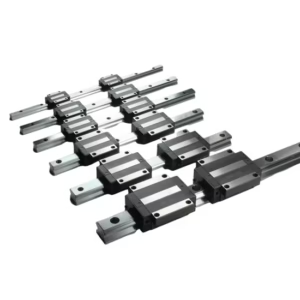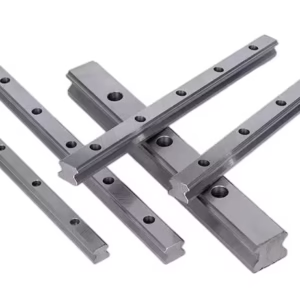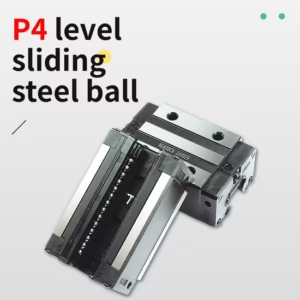Outline for “Linear Rail and Carriage”
| Section Title | Description / Focus |
|---|---|
| Introduction | Overview of linear rail and carriage systems |
| What Is a Linear Rail and Carriage? | Basic concept and functionality |
| Importance in Modern Engineering | Why these systems are vital for precision motion |
| Key Components Explained | Rails, carriages, rolling elements, and seals |
| Working Principle of Linear Rail and Carriage | How they provide frictionless linear motion |
| Types of Linear Rail Systems | Ball, roller, and miniature types |
| Understanding the Carriage | Its design, features, and function |
| Materials Used | Common materials and their advantages |
| Linear Rail and Carriage Design | Geometry, mounting, and configuration |
| Preload and Rigidity | Balancing smoothness and stiffness |
| Accuracy and Repeatability | Maintaining precision under load |
| Load Capacity and Speed | Factors affecting performance |
| Installation and Alignment | Best practices for correct setup |
| Lubrication and Maintenance | Ensuring smooth and long-lasting operation |
| Troubleshooting Common Problems | Causes and solutions to operational issues |
| Applications in Industry | Where linear rails and carriages are used |
| Linear Rail and Carriage in CNC Machines | Ensuring precision and reliability in machining |
| Role in Robotics and Automation | Smooth motion for advanced systems |
| Advantages of Linear Rail and Carriage Systems | Key benefits for industries |
| Environmental and Operational Considerations | Handling heat, dust, and corrosion |
| Selecting the Right Linear Rail and Carriage | Criteria for choosing the ideal system |
| Cost and Value Analysis | Balancing investment and performance |
| Future Trends and Innovations | Smart sensors, materials, and design evolution |
| FAQs | Commonly asked questions |
| Conclusion | Summary and insights |
Linear Rail and Carriage
In the realm of precision engineering and automation, the linear rail and carriage system stands out as one of the most critical components for achieving accurate, stable, and smooth linear motion. Whether in CNC machines, robotic arms, or automated production lines, these systems ensure that parts move precisely where they’re needed—with minimal friction and maximum reliability.
What Is a Linear Rail and Carriage?
A linear rail and carriage system, also known as a linear guide or linear motion guide, is designed to facilitate smooth and controlled movement along a straight path. The rail acts as the fixed guiding track, while the carriage—often called a slider or block—moves along it using rolling elements such as balls or rollers.
This design eliminates the stick-slip behavior found in sliding mechanisms and provides unmatched accuracy, even under high loads and continuous use.
Importance in Modern Engineering
Linear rail and carriage systems play a vital role in modern manufacturing, automation, and robotics. As industries demand tighter tolerances, faster speeds, and greater consistency, the precision and durability of linear guides have become indispensable. They enhance performance in equipment ranging from small 3D printers to massive industrial CNC centers.
These systems not only improve accuracy but also reduce energy loss, wear, and maintenance costs—key factors in optimizing operational efficiency.
Key Components Explained
A linear rail and carriage assembly typically includes the following components:
Rail: The hardened, precision-ground guide that defines the linear path.
Carriage (Block): The moving part that slides along the rail, supporting loads.
Rolling Elements: Recirculating steel balls or rollers that provide low-friction movement.
End Caps and Return Channels: Facilitate continuous recirculation of the rolling elements.
Seals and Scrapers: Prevent dust, chips, and debris from contaminating the interior.
Lubrication Ports: Ensure proper grease or oil distribution to reduce wear.
Each component must be engineered to micron-level tolerances to maintain stability and consistency during motion.
Working Principle of Linear Rail and Carriage
The operation of a linear rail and carriage is based on the rolling contact between the carriage and rail. As the carriage moves, the rolling elements circulate inside return channels, maintaining smooth motion. The rolling action minimizes friction—often up to 1/50th that of sliding systems—allowing for effortless, precise travel under varying loads.
This frictionless design ensures that the system maintains its accuracy, even under heavy-duty or high-speed conditions.
Types of Linear Rail Systems
Several types of linear rail and carriage systems exist, each designed for specific performance needs:
Ball-Type Linear Rails: Use steel balls to provide smooth and quiet operation; ideal for precision applications.
Roller-Type Linear Rails: Employ cylindrical rollers that offer higher load capacity and rigidity.
Miniature Linear Rails: Compact versions designed for lightweight or space-limited equipment.
Flat-Type Linear Guides: Used where low-profile mounting is essential.
Selecting the correct type depends on load requirements, environmental conditions, and accuracy demands.
Understanding the Carriage
The carriage is the heart of the system. It carries the load and interacts with the rail through the rolling elements. Carriages can come in various shapes—long, short, wide, or narrow—depending on the specific application.
Some designs include flanged carriages for easier mounting, while others use compact types for smaller equipment. Internally, the carriage houses recirculating channels that allow rolling elements to move continuously, maintaining consistent performance.
Materials Used
Durability and reliability depend heavily on the materials used:
High-Carbon Bearing Steel: Common in rails and carriages for strength and wear resistance.
Stainless Steel: Offers superior corrosion resistance in humid or chemical environments.
Aluminum Alloys: Used in lightweight applications.
Polymer or Composite Coatings: Reduce noise and prevent contamination.
Heat treatment and precision grinding further enhance material properties and dimensional stability.
Linear Rail and Carriage Design
A well-designed system focuses on rigidity, alignment, and load distribution. The contact angle between rolling elements and the raceway determines load capacity in different directions. Rails are often mounted in pairs for balance, and carriages can be configured to carry torque as well as linear loads.
Preload and Rigidity
Preload eliminates internal clearance between the rail and carriage, increasing stiffness and reducing vibration. However, excessive preload can cause higher friction and reduced lifespan. Engineers must balance preload levels based on the application—high for precision machining, low for smoother motion.
Accuracy and Repeatability
In precision systems, accuracy is everything. Linear rails and carriages are ground and aligned to strict tolerances, ensuring that each movement is exact and repeatable. High-grade models can achieve positional accuracy within microns, making them ideal for semiconductor manufacturing and precision tooling.
Load Capacity and Speed
Linear rails and carriages can support static (stationary) and dynamic (moving) loads. The system’s load capacity depends on the size, number of rolling elements, and contact geometry.
Some modern systems support travel speeds exceeding 5 meters per second, maintaining low noise and minimal wear through advanced lubrication and sealing.
Installation and Alignment
Proper installation ensures performance and longevity. Steps include:
Surface Preparation: Mounting surfaces should be flat, clean, and burr-free.
Alignment: Use a dial indicator to ensure parallel rail placement.
Tightening: Gradually tighten mounting bolts while verifying alignment.
Testing: Manually move the carriage to detect irregularities.
Lubrication: Apply the correct grease before operation.
Even slight misalignment can lead to uneven wear or premature failure.
Lubrication and Maintenance
Lubrication minimizes friction, prevents corrosion, and extends service life. Regular maintenance includes:
Re-lubrication every few months (depending on usage).
Cleaning rails and removing debris.
Replacing seals or wipers when worn.
Checking for unusual vibration or sound.
Proper care ensures consistent performance over years of service.
Troubleshooting Common Problems
| Problem | Possible Cause | Solution |
|---|---|---|
| Jerky or uneven motion | Debris or misalignment | Clean, realign, and re-lubricate |
| Excessive noise | Insufficient lubrication | Apply grease or replace worn elements |
| Vibration or chatter | Incorrect preload | Adjust or re-install system |
| Wear on rail or block | Contamination or overload | Inspect seals and reduce load |
| Corrosion | Poor environment control | Use stainless or coated rails |
Preventive maintenance keeps systems reliable and minimizes downtime.
Applications in Industry
Linear rails and carriages are integral in:
CNC Machines: For precise motion of tools and tables.
Robotic Systems: Enabling smooth and repeatable movement.
3D Printers and Laser Cutters: Ensuring accuracy during operation.
Medical Devices: Guiding sensitive components.
Automation Equipment: Transporting parts quickly and reliably.
Their adaptability makes them indispensable in modern production.
Linear Rail and Carriage in CNC Machines
In CNC machining, precision is everything. The linear rail and carriage system allows the cutting tool and worktable to move smoothly under load, ensuring accuracy even under vibration or high-speed operation. The result? Superior surface finish and consistent dimensional quality.
Role in Robotics and Automation
Robots rely heavily on linear guides for controlled motion. Linear rails and carriages provide rigidity and stability for multi-axis movements, helping robotic arms perform precise operations like assembly, welding, and pick-and-place with remarkable accuracy.
Advantages of Linear Rail and Carriage Systems
High Precision and Repeatability
Low Friction and Energy Consumption
Compact and Efficient Design
Long Service Life
Low Maintenance
Excellent Load Distribution
These advantages make linear rails and carriages the backbone of motion control technology.
Environmental and Operational Considerations
Linear systems often work in environments that challenge their performance. Dust, coolant, or high humidity can degrade performance unless properly sealed. Using stainless steel rails or protective coatings can significantly improve resistance to corrosion and debris intrusion.
Selecting the Right Linear Rail and Carriage
To choose the ideal system:
Define load and speed requirements.
Evaluate accuracy and rigidity needs.
Consider environmental conditions.
Check space and mounting constraints.
Select appropriate lubrication and maintenance options.
The right combination ensures longevity and performance efficiency.
Cost and Value Analysis
Although high-precision linear rails and carriages may have a higher upfront cost, they pay off through increased accuracy, reduced downtime, and longer service life. Investing in quality components minimizes long-term operational costs.
Future Trends and Innovations
The future of linear rail and carriage technology focuses on intelligent, low-maintenance systems:
Smart Sensors: Monitor load, temperature, and vibration.
Self-Lubricating Designs: Reduce maintenance intervals.
Advanced Coatings: Offer greater resistance to corrosion.
Lightweight Materials: Enhance speed and energy efficiency.
These innovations will redefine performance expectations in precision motion systems.
FAQs
What does a linear rail and carriage do?
It enables smooth, precise linear motion for mechanical systems with minimal friction.
How long do linear rails last?
With proper maintenance, they can operate for tens of thousands of hours.
Can linear guides handle heavy loads?
Yes, especially roller-type systems, which provide higher load capacity and stiffness.
Do they require lubrication?
Absolutely. Lubrication is essential for minimizing wear and extending lifespan.
Can they operate in dirty environments?
Yes, provided they have effective seals and protective coatings.
How often should they be serviced?
Regular inspection every few months ensures optimal performance and prevents breakdowns.
Conclusion
The linear rail and carriage system is a cornerstone of precision engineering, ensuring stable, accurate, and reliable linear motion across countless applications. Its low friction, high rigidity, and longevity make it an essential component in modern manufacturing and automation. With continuous innovations in design and materials, the future promises even greater performance and efficiency from these remarkable systems.
Suggested Inbound Links
Guide to linear motion systems
CNC precision setup tutorial
Bearings and lubrication best practices
Suggested Outbound Links
ISO standards for linear rails
Industrial automation technology resources




